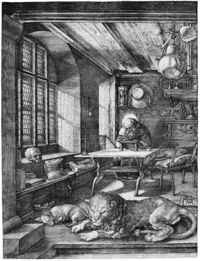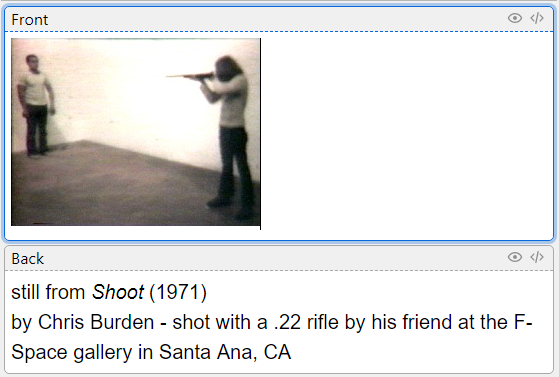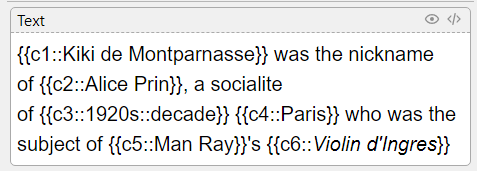Difference between revisions of "How to flashcard/FAQ"
Kevin Wang (talk | contribs) |
Kevin Wang (talk | contribs) |
||
| Line 4: | Line 4: | ||
As with the parent page, this page was written by [[User:Kevin Wang]] and thus reflects many of their particular thoughts. | As with the parent page, this page was written by [[User:Kevin Wang]] and thus reflects many of their particular thoughts. | ||
| − | {{Under construction}} | + | {{Under construction}}{{-}} |
<onlyinclude> | <onlyinclude> | ||
==How should I card <thing>?== | ==How should I card <thing>?== | ||
| Line 32: | Line 32: | ||
Ex. 2 is a cloze style card which excludes any images. In this particular case, there could be an image included (of Alice Prin, of ''Violin d'Ingres'', or of one of the other works inspired by Prin) but it would make it difficult to properly test on certain pieces of knowledge - it would likely be easier to simply create a second front-back card with the image (for more details on the trade-offs, see: [[How to flashcard/FAQ#Should I use an image on a card?|Should I use an image on a card?]]). As is, this card is taking advantage of the major advantage of a cloze-type card: you can test yourself on multiple pieces of information related to the primary fact. | Ex. 2 is a cloze style card which excludes any images. In this particular case, there could be an image included (of Alice Prin, of ''Violin d'Ingres'', or of one of the other works inspired by Prin) but it would make it difficult to properly test on certain pieces of knowledge - it would likely be easier to simply create a second front-back card with the image (for more details on the trade-offs, see: [[How to flashcard/FAQ#Should I use an image on a card?|Should I use an image on a card?]]). As is, this card is taking advantage of the major advantage of a cloze-type card: you can test yourself on multiple pieces of information related to the primary fact. | ||
|- | |- | ||
| − | | | + | |- |
| − | + | | Poetry | |
| − | | | + | | |
| − | | There is | + | | Besides the obvious stylistic differences with prose, poetry has a lot of aspects that affect the way you would want to translate it into cards. |
| + | |||
| + | Some major factors: | ||
| + | *Poems are short. There are, of course, very long poems. But in general it is possible to know a significant fraction of the lines in the poem and, indeed, questions often expect players to know quotes to get points. '''Writing cards on specific lines''' is significantly more viable than doing the same for a short story or novel, both in terms of practicality and points. | ||
| + | *Poems are often published in collections. This is also true of other shorter forms of literature, like short stories. Knowing when and where a poem can be read is a more complicated question than for novels, where publishers and editions are rarely of relevance. '''Include information about collections''' on the backs of your cards, as well as dedicated cards for collections of note. | ||
|- | |- | ||
|colspan=3| WIP | |colspan=3| WIP | ||
| Line 48: | Line 52: | ||
|- | |- | ||
| The image is the primary subject of the card | | The image is the primary subject of the card | ||
| − | | A front-back card may be better suited for your purposes. | + | | '''A front-back card may be better suited for your purposes.''' |
It is technically possible to embed an image into your card and then have a list of clozed facts beneath it - when there is a single fact (or set of facts) and a single cloze, this is equivalent to a front-back card. However, having more information available can make each individual card easier or even trivial. | It is technically possible to embed an image into your card and then have a list of clozed facts beneath it - when there is a single fact (or set of facts) and a single cloze, this is equivalent to a front-back card. However, having more information available can make each individual card easier or even trivial. | ||
|- | |- | ||
| The image does not directly help answer the card | | The image does not directly help answer the card | ||
| − | | This would likely be fine in a cloze card (where such an image would always be visible) or on the front of a standard card. | + | | '''This would likely be fine in a cloze card (where such an image would always be visible) or on the front of a standard card.''' |
Some examples: | Some examples: | ||
| Line 63: | Line 67: | ||
|- | |- | ||
| The image is evocative enough to provide an alternative route to answering the card | | The image is evocative enough to provide an alternative route to answering the card | ||
| − | | Such images can still be useful, but should be kept off the front of cards. They can act as useful tools for anchoring facts on the back of a card, though. | + | | '''Such images can still be useful, but should be kept off the front of cards.''' They can act as useful tools for anchoring facts on the back of a card, though. |
Some examples: | Some examples: | ||
*a diagram whose text contains the answer to the card you are answering | *a diagram whose text contains the answer to the card you are answering | ||
| − | *a picture of the answer that recognize (like a portrait of | + | *a picture of the answer that you recognize (like a famous portrait of a historical figure) |
*the answer to the card, but restated (e.g. a formula or equation which is also described in text) | *the answer to the card, but restated (e.g. a formula or equation which is also described in text) | ||
| Line 79: | Line 83: | ||
# [[How to flashcard#Amending old cards|Amending old cards]] | # [[How to flashcard#Amending old cards|Amending old cards]] | ||
# [[How to flashcard#Prepare for lapses|Prepare for lapses]] | # [[How to flashcard#Prepare for lapses|Prepare for lapses]] | ||
| − | # [[How to flashcard#Bad cards produce bad buzzes|Bad cards | + | # [[How to flashcard#Bad cards produce bad buzzes|Bad cards produce bad buzzes]] |
Some options - try one (or multiple of these): | Some options - try one (or multiple of these): | ||
| Line 106: | Line 110: | ||
|- | |- | ||
| Add a new card on the topic | | Add a new card on the topic | ||
| − | | | + | | A lot of times you have a perfectly reasonable card which you simply can't remember. |
| + | A good example would be a front-back card where you simply can't remember what author wrote a book. | ||
| + | There's nothing theoretically wrong with the card and the information is presumably something you wish to retain, so what can be done? | ||
| + | |||
| + | One option is discussed in the previous row (adding information to the back) but another is simply to create additional cards about the topic. Maybe you can't remember facts about the book because you don't know any details about it - it's just a name to you. Writing a card about the book's plot and character could give you context you need for it to finally stick in your mind. | ||
| | | | ||
|- | |- | ||
| Abandon the card entirely | | Abandon the card entirely | ||
| − | | Listen - sometimes you wrote a card and it's not good. I would personally advocate for trying to make it better, but sometimes it's better to replace it with something brand new or just ditch it wholesale. | + | | Listen - sometimes you wrote a card and it's not good. I would personally advocate for ''trying'' to make it better, but sometimes it's better to replace it with something brand new or just ditch it wholesale. |
| − | | You don't need | + | | You don't need a demo - just throw it away! |
|} | |} | ||
</onlyinclude> | </onlyinclude> | ||
Revision as of 09:40, 9 June 2023
A short frequently-asked questions section meant to accompany How to flashcard. Actionable responses to common questions.
As with the parent page, this page was written by User:Kevin Wang and thus reflects many of their particular thoughts.
This page is under construction.
Forgive the mess.
How should I card <thing>?
Your mileage may vary but here are some reasonable approaches for various common things that one might want to card.
This topic is also discussed in the following section(s):
| Topic | Example | Additional notes |
|---|---|---|
| VFA | Example 2: |
Art has an obvious visual component, which you should take advantage of. Besides the benefit of providing direct interaction with the subject matter, using an image can improve retention. Despite this, it is often useful to include cards of other types for efficiency's sake to ensure that you have good coverage of the facts you wish to retain.
Ex. 1 is a front-back style card which uses an image as its front. This has many of the disadvantages of other cards of this type; namely, it primarily tests on a single atomic connection. In this example this is fine, as the set of relevant information is the compact set of <the name of the work, the artist, some basic context>. The year, the state it took place in, and some of the specifics are likely never to be asked about. Nevertheless, it is still useful to provide these other bits of information, as the simple act of exposing yourself to this extra information will give more for your brain to hold onto and will make this card more useful as a reference outside of reviews. If you wanted to test on any of these (perhaps you become convinced of its importance), you could simply create a new card. Ex. 2 is a cloze style card which excludes any images. In this particular case, there could be an image included (of Alice Prin, of Violin d'Ingres, or of one of the other works inspired by Prin) but it would make it difficult to properly test on certain pieces of knowledge - it would likely be easier to simply create a second front-back card with the image (for more details on the trade-offs, see: Should I use an image on a card?). As is, this card is taking advantage of the major advantage of a cloze-type card: you can test yourself on multiple pieces of information related to the primary fact. |
| Poetry | Besides the obvious stylistic differences with prose, poetry has a lot of aspects that affect the way you would want to translate it into cards.
Some major factors:
| |
| WIP | ||
Should I use an image on a card?
Having an image in a card can help you remember it, because it gives you something extra to think about. In general, it is good to include them - like everything, though, there are exceptions.
| What is the image? | Recommendation |
|---|---|
| The image is the primary subject of the card | A front-back card may be better suited for your purposes.
It is technically possible to embed an image into your card and then have a list of clozed facts beneath it - when there is a single fact (or set of facts) and a single cloze, this is equivalent to a front-back card. However, having more information available can make each individual card easier or even trivial. |
| The image does not directly help answer the card | This would likely be fine in a cloze card (where such an image would always be visible) or on the front of a standard card.
Some examples:
Avoid using images of things you already have associations with (e.g. don't put an image of Saoirse Ronan in your card on Little Women if you've seen the film, as you may not bother reading the actual facts you've included). |
| The image is evocative enough to provide an alternative route to answering the card | Such images can still be useful, but should be kept off the front of cards. They can act as useful tools for anchoring facts on the back of a card, though.
Some examples:
Remember, the goal of a card is to help you associate two pieces of information - short-circuiting that process will prevent you from gaining any benefit from your cards. |
I keep failing a card, how can I remember it better?
The platonic ideal of a flashcard contains a single fact on the front which you are able to perfectly associate with the corresponding answer on the back. If you are unable to successfully recall the back, it is time to move away from this template.
This topic is also discussed in the following section(s):
Some options - try one (or multiple of these):
| Summary | Details | Example(s) |
|---|---|---|
| Add additional information to the front | There may not be enough information on the front of the card for your mind to latch onto - alternatively, you may not have provided enough information for the fact to obviously point towards the answer (or at all). This is particularly common for basic cards like front-back "work-author".
Specific things you might want to add:
|

This card is actually not unique, as the novella by Leskov was (quite significantly) adapted to an opera by Dmitri Shostakovich. This can be pretty straightforwardly resolved by saying that this card is referring to the novella. |
| Add additional information to the back | Adding information to the back of a card will not help you the next time you see it, but it may improve your odds every subsequent time. This is, in some sense, an alternative to writing a second card on the same subject - it may make more sense to add information if you are either okay with repeating yourself or if you truly do not believe that you will be tested on that additional fact.
As a side note, cards created through cloze deletion only sort-of have a back - the closest they get is the contents of any individual cloze. |
|
| Add a new card on the topic | A lot of times you have a perfectly reasonable card which you simply can't remember.
A good example would be a front-back card where you simply can't remember what author wrote a book. There's nothing theoretically wrong with the card and the information is presumably something you wish to retain, so what can be done? One option is discussed in the previous row (adding information to the back) but another is simply to create additional cards about the topic. Maybe you can't remember facts about the book because you don't know any details about it - it's just a name to you. Writing a card about the book's plot and character could give you context you need for it to finally stick in your mind. |
|
| Abandon the card entirely | Listen - sometimes you wrote a card and it's not good. I would personally advocate for trying to make it better, but sometimes it's better to replace it with something brand new or just ditch it wholesale. | You don't need a demo - just throw it away! |



